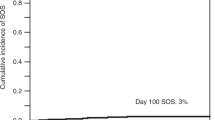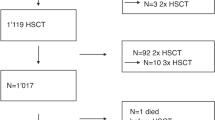Summary:
Veno-occlusive disease (VOD) is one of the most serious complications following hematopoietic stem cell transplantation (HSCT) and is associated with a high mortality. We conducted a large trial on the clinical significance of protein C (PC) and procollagen III peptide (PNPIII) levels, which have been described as possible diagnostic markers of VOD. In total, 350 patients undergoing allogeneic HSCT were included. PC and PNPIII levels were analyzed prior to conditioning and weekly until 8 weeks after the HSCT. Signs of VOD and other transplantation-related complications (graft-versus-host disease (GVHD), toxicity, microangiopathic hemolytic anemia, infection) were recorded weekly throughout the trial. Patients showed a significant drop of the PC levels in VOD (70.3 vs 96.3%, P<0.001) and with increasing severity of aGVHD. Steroids increased the PC levels (69.4% vs 109.4%, P<0.001). The highest PNPIII levels were registered in patients with VOD (mean 6.3 IU/ml). Patients with aGVHD showed an elevation of PNPIII, especially patients with hepatic aGVHD. PC levels during conditioning do not predict VOD (98.5 vs 76.5%, NS). Although PC and PNPIII may play a role in the pathogenesis of VOD they cannot discriminate between complications with jaundice and are only of limited help in the differential diagnosis of VOD.
This is a preview of subscription content, access via your institution
Access options
Subscribe to this journal
Receive 12 print issues and online access
$259.00 per year
only $21.58 per issue
Buy this article
- Purchase on Springer Link
- Instant access to full article PDF
Prices may be subject to local taxes which are calculated during checkout



Similar content being viewed by others
References
Wadleigh M, Ho V, Momtaz P, Richardson P . Hepatic veno-occlusive disease: pathogenesis, diagnosis and treatment. Curr Opin Hematol 2003; 10: 451–462.
Jones RJ, Lee KS, Beschorner WE et al. Venoocclusive disease of the liver following bone marrow transplantation. Transplantation 1987; 44: 778–783.
McDonald GB, Hinds MS, Fisher LD et al. Veno-occlusive disease of the liver and multiorgan failure after bone marrow transplantation: a cohort study of 355 patients. Ann Intern Med 1993; 118: 255–267.
Carreras E, Bertz H, Arcese W et al. Incidence and outcome of hepatic veno-occlusive disease after blood or marrow transplantation: a prospective cohort study of the European Group for Blood and Marrow Transplantation. European Group for Blood and Marrow Transplantation Chronic Leukemia Working Party. Blood 1998; 92: 3599–3604.
Faioni EM, Kraachmalnicoff A, Bearmann SI et al. Naturally occuring anticoagulants and bone marrow transplantation: plasma Protein C predicts the development of veno-occlusive disease of the liver. Blood 1993; 81: 3458–3462.
Heikinheimo M, Halila R, Fasth A . Serum procollagen type III is an early and sensitive marker for veno-occlusive disease of the liver in children undergoing bone marrow transplantation. Blood 1994; 83: 3036–3040.
Richardson PG, Murakami C, Jin Z et al. Multi-institutional use of defibrotide in 88 patients after stem cell transplantation with severe veno-occlusive disease and multisystem organ failure: response without significant toxicity in a high-risk population and factors predictive of outcome. Blood 2002; 100: 4337–4343.
Salat C, Holler E, Goehring P et al. Protein C, protein S and antithrombin III levels in the course of bone marrow and subsequent liver transplantation due to veno-occlusive disease. Eur J Med Res 1996; 1: 571–574.
Salat C, Holler E, Wolf C et al. Laboratory markers of veno-occlusive disease in the course of bone marrow and subsequent liver transplantation. Bone Marrow Transplant 1997; 19: 487–490.
Glucksberg H, Storb R, Fefer A et al. Clinical manifestations of graft-versus-host disease in human recipients of marrow from HL-A-matched sibling donors. Transplantation 1974; 18: 295–304.
Shulman HM, Sullivan KM, Weiden PL et al. Chronic graft-versus-host syndrome in man. A long term clinicopathologic study of 20 Seattle patients. Am J Med 1980; 69: 204–217.
Holler E, Kolb HJ, Hiller E et al. Microangiopathy in patients on cyclosporine prophylaxis who developed acute graft-versus-host disease after HLA-identical bone marrow transplantation. Blood 1989; 73: 2018–2024.
Zeigler ZR, Shadduck RK, Nemunaitis J et al. Bone marrow transplant-associated thrombotic microangiopathy: a case series. Bone Marrow Transplant 1995; 15: 247–253.
Pihusch R, Salat C, Schmitt E et al. Hemostatic complications in bone marrow transplantation: a retrospective analysis of 447 patients. Transplantation 2002b; 74: 1303–1916.
Herbetko J, Grigg AP, Buckley AR, Phillips GL . Veno-occlusive liver disease after bone marrow transplantation: findings at duplex sonography. Am J Roentgenol 1992; 158: 1001–1005.
Shulman HM, Gooley T, Dudley MD et al. Utility of transvenous liver biopsies and wedged hepatic venous pressure measurements in sixty marrow transplant recipients. Transplantation 1995; 59: 1015–1022.
Park YD, Yasui M, Yoshimoto T et al. Changes in hemostatic parameters in hepatic veno-occlusive disease following bone marrow transplantation. Bone Marrow Transplant 1997; 19: 915–920.
Schuler U, Subat S, Schmidt H et al. Evaluation of procollagen-III peptide as a marker for veno-occlusive disease after bone marrow transplantation. Ann Hematol 1996; 73: 25–28.
Scrobohaci ML, Drouet L, Monem-Mansi A et al. Liver veno-occlusive disease after bone marrow transplantation – Changes in coagulation parameters and endothelial markers. Thromb Res 1991; 63: 509–519.
Lee JH, Lee KH, Kim S et al. Relevance of proteins C and S, antithrombin III, von Willebrand factor, and factor VIII for the development of hepatic veno-occlusive disease in patients undergoing allogeneic bone marrow transplantation: a prospective study. Bone Marrow Transplant 1998; 22: 883–888.
Eltumi M, Trivedi P, Hoob JR et al. Monitoring of veno-occlusive disease after bone marrow transplantation by serum aminopeptide of type III procollagen. Lancet 1993; 342: 518–521.
Rio B, Bauduer F, Arrago JP, Zittoun R . N-terminal peptide of type III procollagen: a marker for the development of hepatic veno-occlusive disease after BMT and a basis for determining the timing of prophylactic heparin. Bone Marrow Transplant 1993; 11: 471–472.
DeLeve LD, Ito Y, Bethea NW et al. Embolization by sinosoidal lining cells obstructs the microcirculation in rat sinusoidal obstruction syndrome. Am J Physiol Gastrointest Liver Physiol 2003; 284: G1045–G1052.
Grey ST, Hancock WW . A physiologic anti-inflammatory pathway based on thrombomodulin expression and generation of activated protein C by human mononuclear phagocytes. J Immunol 1996; 156: 2256–2263.
Pihusch R, Holler E, Muehlbayer D et al. The impact of antithymocyte globulin on short-term toxicity after allogeneic stem cell transplantation. Bone Marrow Transplant 2002a; 30: 347–354.
Oh S, Afdhal NH . Hepatic fibrosis: are any of the serum markers useful? Curr Gastroenterol Rep 2001; 3: 12–18.
Jensen LT . The aminoterminal propeptide of type III procollagen. Studies on physiology and pathophysiology. Dan Med Bull 1997; 44: 70–78.
Remuzzi G, Perico N . Cyclosporine-induced renal dysfunction in experimental animals and humans. Kidney Int Suppl 1995; 52: S70–S74.
Acknowledgements
This work is part of the doctoral thesis of Holger Wegner.
Author information
Authors and Affiliations
Corresponding author
Rights and permissions
About this article
Cite this article
Pihusch, M., Wegner, H., Goehring, P. et al. Protein C and procollagen III peptide levels in patients with hepatic dysfunction after allogeneic hematopoietic stem cell transplantation. Bone Marrow Transplant 36, 631–637 (2005). https://doi.org/10.1038/sj.bmt.1705114
Received:
Accepted:
Published:
Issue Date:
DOI: https://doi.org/10.1038/sj.bmt.1705114



